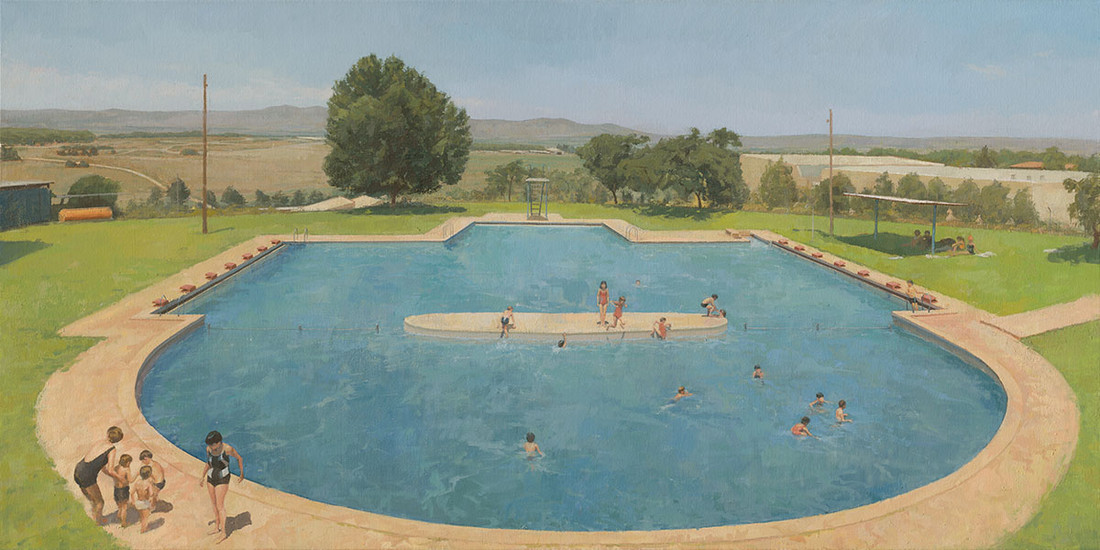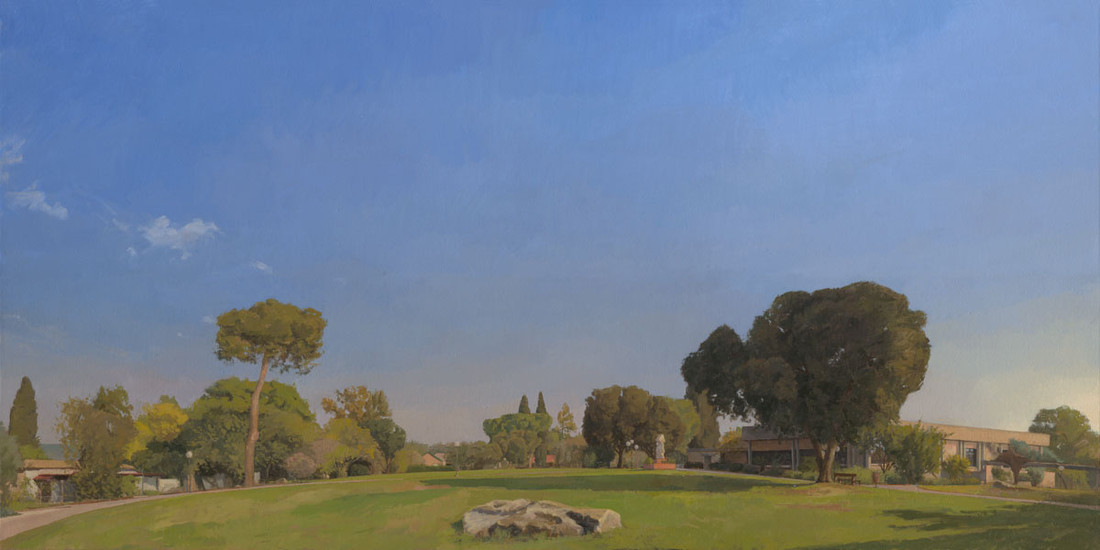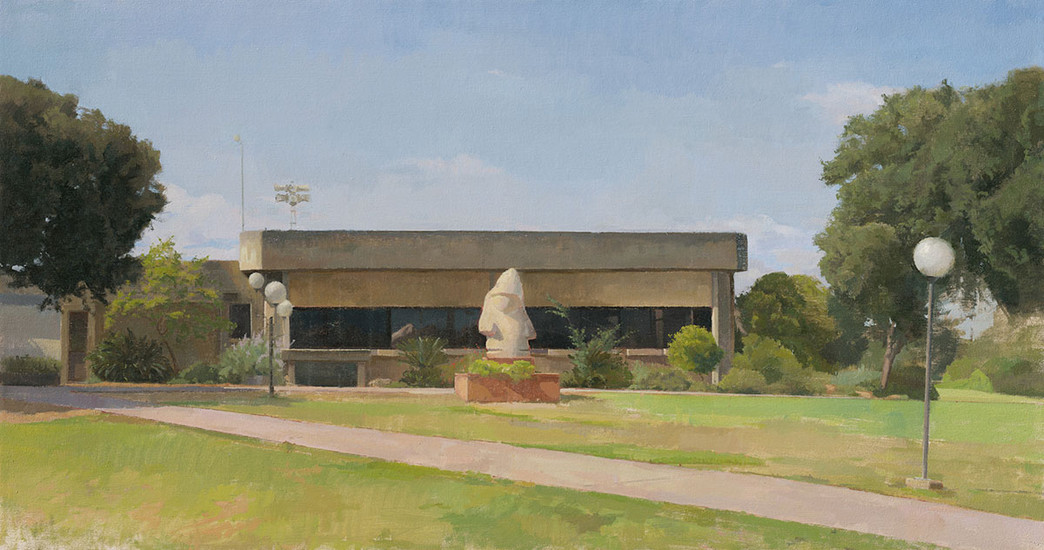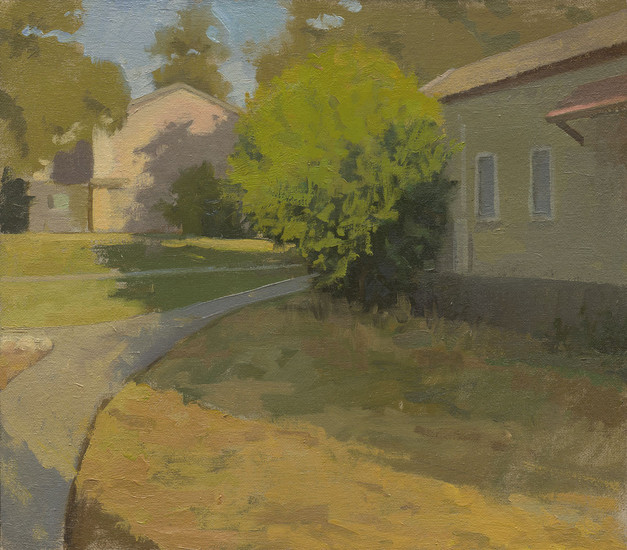The Human Dimension
Ofir Begun
In Ofir Begun’s paintings, green color predominates: every possible shade of it, in cultivated nature and vast areas of well-tended grass. Scattered within that green landscape are small houses with tiled roofs, trees with luxuriant crowns, narrow paths, streetlights. The picture is almost idyllic, as on the Rosh Hashana (the Jewish New Year) postcards that used to be printed in kibbutzim – open spaces resplendent with light, greenery and blue skies. However, this pastoral bliss is not without blight, which the viewer may discern on a closer look. One such flaw in the ostensibly paradisical scene is palpable in the only painting in the exhibition that offers a view from indoors outwards, that of an empty dining hall. The vista from the enclosed to open space also connects past and present. The shiny floor reflects the light and the scenery, further emphasizing the emptiness of the hall, which used to be the hub of life in the settlement.
Ofir Begun was born and raised in Kibbutz Yifat in the Jezreel Valley. In his paintings he revisits and explores the spaces of his childhood, and in the process charts out a generic, almost prototypical kibbutz layout. He is enthralled by the sense of freedom that the vast open spaces of the kibbutz can afford, and that he, himself, experienced as a child. In his paintings, he asks if this kind of collective space can be feasible in today’s reality as well. Can it present an alternative to the fenced in, privatized spaces that surround us? The kibbutz space was unique, in that it was tailored to a distinctive worldview and to the lifestyle derived therefrom: the buildings were markedly small because the kibbutz members led their lives mostly outdoors, in the open space; the lawns were wide, with
no nooks and crannies where one could hide, so as not to subvert the sense of togetherness; the paths crisscrossing the grass resembled flowing streams; as for the trees, each had a story of its own. The entire kibbutz was perceived as a family home, and the world beyond was just a silhouette of mountains; it might not have existed at all.
Inside the kibbutz, there were no physical boundaries, no separation between private and public, or indeed between private and private. The entire kibbutz space formed a single unbroken continuity.
The roots of the typical spatial layout of the kibbutz go back to the early twentieth century. As a new type of classless society, the kibbutz had to develop a categorically new landscape, different from the nostalgic image of the traditional agricultural village, but also from the urban and suburban spatial models. The planners of the first kibbutzim invested a lot of thought in mapping out the open space, which was perceived, in and of itself, as a separate entity rather than as a collection of snippets left over from the construction or as a setting for imposing architecture. The kibbutz space was seen as a public arena where the lives of its members played out in full, day after day. In the kibbutz, the open space and the closed spaces stood in striking contrast. The reductionist design of the buildings was centered on efficiency, and every inch in them was utilized meticulously and deliberately. The open space, on the other hand, was vast, seemingly much larger than required. Owing to the joint ownership of the land and the absence of parcelling, it constituted a continuous system of spaces that emanated from the center of the kibbutz and branched out towards the children’s homes and members’ residences. In the center, resonating with the formal character of the
dining hall, was a green expanse known as “the big lawn,” which doubled as the main square of the kibbutz. It is this space that keeps reappearing in Ofir’s paintings.
The spatial layout of the kibbutz as one continuous area, with no internal divisions or boundaries, reinforced the feeling that the entire kibbutz is an inclusive home whose rooms are dispersed throughout its territory. This home had bedrooms, children’s rooms, a dining hall, a clinic, and shared showers. All these rooms were connected by “corridors,” that is, the paths intersecting the kibbutz area in every direction. The lawns served as front porches. As such, they were important venues for the kibbutz members, who used them for social gatherings, ceremonies, and holiday celebrations, but also to stroll through in small groups, greeting friends casually along the way. A lawn was thus both an open outdoor space and an indoor corridor, a passage that is both public and private, but possibly neither.
But all this belongs to the past. The scenes in Ofir's paintings have ostensibly remained the same as in the past, as if frozen in time. And yet, they are different. An arresting feature of his compositions is the absence of people. This is how Ofir, himself, explains it: "Each painting condenses a very long experience of observing; it might seem that, in it, I caught a certain moment in time, but in fact this moment consists of lots of moments at different times and conditions, and I try to put them all together. If during the time I am painting a scene some passers-by enter the frame, it does not matter to me. It is not them that I came there to draw; they are like objects moving at the speed of light – I am not even
able to see them." Sometimes he goes back to paint the same place over and over again, for weeks and even years, adding layers of depth and possibilities. Gradually, more and more details accumulate, and with them, there emerges the dimension of time.
And for all that, Ofir’s paintings are by no means divested of human experience. The human dimension is present in the traces people have left behind in the air, in memories permeating the scene. This is what draws Ofir to the distinctive aesthetics of the kibbutz: "I always paint a human landscape. I paint fields, path-walks, houses. It is always a landscape designed and constructed by people. Even though human figures are absent from the picture, man is present everywhere." The compositional aspect of the paintings likewise incorporates the human dimension, more so than might be apparent at first glance. For example, in the panoramic painting entitled The Center of the Universe, the rock in the middle of the composition is like the heart of The Big Lawn. This was the place where children and young kibbutz members used to meet, where they started their games of tag and hide-and-seek. The rock was the center of the kibbutz. And for a child, the kibbutz was the center of the world.
Today, the lawns of the kibbutzim are empty, as they are in Ofir Begun’s paintings. In the past, large resources were invested in the kibbutz landscapes and scenery, and especially in lawns. Lawns were seen as having great aesthetic and social value, and no cost or effort were spared for their upkeep, sometimes with no consideration of the local climate. Today, in many kibbutzim, the dining hall is closed, the grass is neglected,
and the vast open space remains practically unused. More often than not, this broad area seems to have turned from an asset into a burden. The privatization process has defined and delimited private spaces with greater precision. The houses have become bigger and are now surrounded by private yards within hedges. Cars have invaded the kibbutz territory and travel along its roads. Each house is furnished with two parking spaces. "Unfortunately," says Ofir, "the spatial acumen, so unique to the kibbutz, is being lost. The face of the kibbutz is rapidly changing – the kibbutz is steadily turning to a regular suburb." And yet the places Ofir chose to paint are those that had remained unchanged from the past. Is it out of longing, romanticism, or as a real, feasible alternative?
That depends on the angle we choose to look at them. Dr. Idit Shachnai Ran
June 2022





